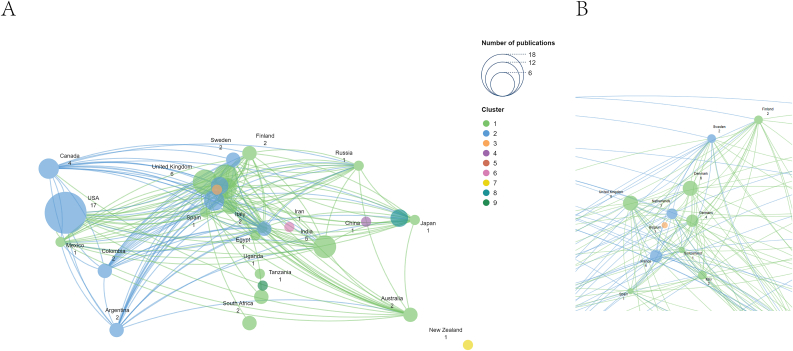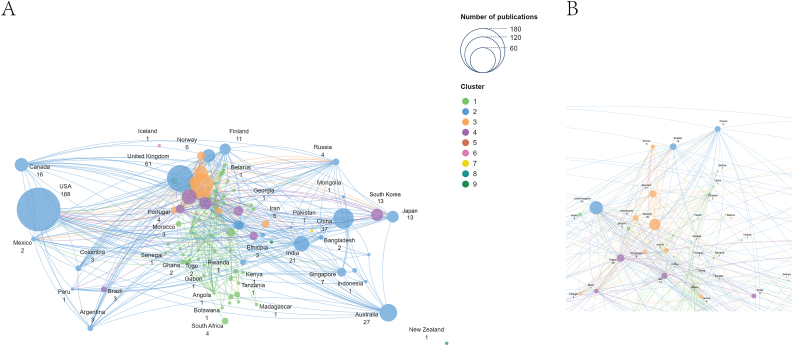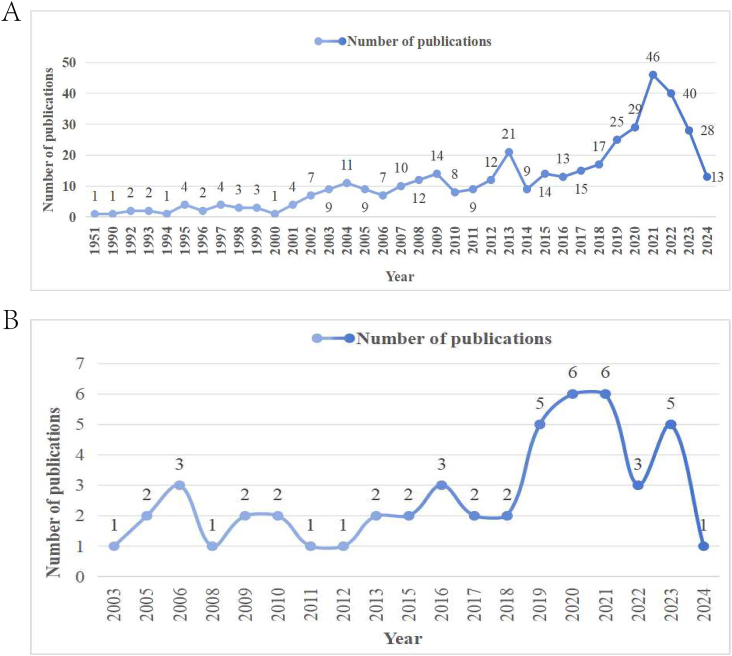眼癌的全球发病率和趋势:文献计量学分析。
IF 3.4
Advances in ophthalmology practice and research
Pub Date : 2025-02-01
DOI:10.1016/j.aopr.2024.10.004
引用次数: 0
摘要
背景:眼癌是各种眼病中对视力和生命构成重大威胁的疾病。结膜黑色素瘤被认为是最令人恐惧和难以预测的眼部肿瘤之一。考虑到全球不同种族和地区眼部黑色素瘤发生的差异,本研究提供了有关眼部和结膜癌流行病学研究现状的全面检查。方法:文献计量学分析采用Web of Science Core Collection (WoSCC)数据库,收集1951 - 2024年眼部肿瘤流行病学相关文献资料。我们检查的指标包括出版物数量、引用率以及贡献国家、机构和期刊的数据。使用VOSviewer和CiteSpace进行网络可视化,使用Microsoft Excel进行数据管理。我们的分析揭示了各国眼癌流行病学的主要趋势,并确定了突出的关键词。结果:共确定了406篇关于眼癌的文章,其中来自美国、英国和德国的贡献很大。丹麦也发挥着至关重要的作用,特别是在结膜癌研究方面。卡罗尔·l·希尔兹是一位领军人物,因其在眼癌流行病学方面的有影响力的引用而得到广泛认可。顶级出版平台包括《英国眼科杂志》、《眼科流行病学》和《眼科学》。眼癌研究的关键术语集中于患病率、生存率和流行病学,而结膜癌研究强调恶性黑色素瘤、结膜和流行病学。通过关键词共现和突发分析,趋势话题包括患病率、危险因素、葡萄膜黑色素瘤、脉络膜黑色素瘤、恶性黑色素瘤、鳞状细胞癌、结膜。结膜癌的重点研究领域是细胞癌、治疗、复发、眼表鳞状瘤变和病理学。结论:这一分析是第一次全面的文献计量学综述,从流行病学的角度,绘制了眼癌研究的趋势和知识结构。研究结果为致力于结膜癌流行病学的学者精心探索和概括了研究前沿。本文章由计算机程序翻译,如有差异,请以英文原文为准。



Global incidence and trends of ocular cancer: A bibliometric analysis
Background
Ocular cancer represents a significant threat to vision and life among various eye diseases. Conjunctival melanoma is regarded as one of the most feared and unpredictable ocular tumors. Considering the global differences in the occurrence of ocular melanoma across different races and regions, this study provides a thorough examination of the current state of research pertaining to the epidemiology of ocular and conjunctival cancers.
Methods
This bibliometrics analysis used the Web of Science Core Collection (WoSCC) to collect data from publications on the epidemiology of ocular cancer, including relevant literature from 1951 to 2024. We examined indicators including t publication counts, citation rates, and data on contributing countries, institutions, and journals. Use VOSviewer and CiteSpace for network visualization and Microsoft Excel for data management. Our analysis reveals key trends in the epidemiology of ocular cancer across countries and identifies prominent keywords.
Results
A total of 406 articles on ocular cancer were identified, with significant contributions from the United States, the United Kingdom, and Germany. Denmark also plays a crucial role, particularly in conjunctival cancer research. Carol L. Shields is a leading figure widely recognized for her influential citations in ocular cancer epidemiology. The top publication platforms include the British Journal of Ophthalmology, Ophthalmic Epidemiology, and Ophthalmology. Key terms in ocular cancer research focus on prevalence, survival, and epidemiology, while conjunctival cancer studies emphasize malignant melanoma, conjunctiva, and epidemiology. Through keyword co-occurrence and burst analysis, trending topics include prevalence, risk factors, uveal melanoma, choroidal melanoma, malignant melanoma, squamous cell carcinoma, and conjunctiva. For conjunctival cancer, key research areas expected to remain prominent are cell carcinoma, management, recurrence, ocular surface squamous neoplasia, and pathology.
Conclusions
This analysis represents the first comprehensive bibliometric review mapping the trends and the knowledge structure in ocular cancer research, specifically from an epidemiological viewpoint. The results meticulously explore and encapsulate the research frontiers for scholars dedicated to the epidemiology of conjunctival cancer.
求助全文
通过发布文献求助,成功后即可免费获取论文全文。
去求助
来源期刊

Advances in ophthalmology practice and research
Ophthalmology
CiteScore
1.70
自引率
0.00%
发文量
0
审稿时长
66 days
 求助内容:
求助内容: 应助结果提醒方式:
应助结果提醒方式:


